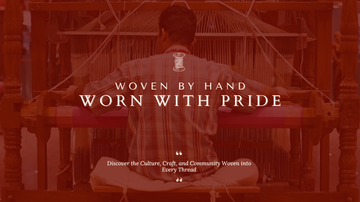Weaving India's Soul: Celebrating the Legacy of Handloom Artisans
India’s rich cultural heritage is deeply intertwined with the artistry of handloom weavers. For centuries, handloom artisans have played a vital role in shaping the country’s textile traditions, preserving intricate techniques, and passing down their craftsmanship through generations. From the Banaras silk sarees of Uttar Pradesh to the Pashmina shawls of Kashmir, each region of India tells a story through its weaves.
A Legacy of Tradition and Craftsmanship
Handloom weaving in India dates back thousands of years, with references found in ancient scriptures like the Rigveda. The diversity in weaving techniques reflects India’s cultural depth, with every state boasting its own unique style. For instance, Gujarat’s Patola silk, Odisha’s Sambalpuri Ikat, and Tamil Nadu’s Kanjeevaram silk are just a few examples of the country's rich textile traditions.
These weaves are more than just fabrics; they represent the stories, history, and heritage of India. Handloom artisans spend years mastering the art, ensuring that each piece is not only a work of beauty but also a symbol of cultural identity.
Sustaining India’s Economy and Rural Livelihoods
Handloom weaving is the second-largest employment provider in India’s rural sector after agriculture. Millions of artisans, especially women, are engaged in this craft, supporting their families and contributing to the economy. The sector empowers rural communities by providing sustainable livelihoods and keeping traditional skills alive.
Government initiatives such as the National Handloom Development Programme (NHDP) and India Handloom Brand have played a crucial role in promoting and protecting handloom artisans. Despite these efforts, artisans still face challenges such as competition from power looms, low wages, and a declining interest among younger generations.
Handloom in Contemporary Fashion
In recent years, there has been a resurgence of interest in handloom fabrics, with designers and fashion enthusiasts embracing sustainable, eco-friendly textiles. Celebrities and influencers are championing handwoven sarees and fabrics, bringing them back into mainstream fashion. Ethical fashion movements and conscious consumerism have further encouraged people to support artisans and choose handmade over mass-produced garments.
Preserving Handloom for the Future
To ensure that India’s handloom heritage continues to thrive, it is crucial to:
-
Support Local Weavers: Buying directly from artisans or through government-backed platforms ensures fair wages and sustains their craft.
-
Promote Handloom Education: Encouraging younger generations to learn and appreciate traditional weaving techniques will keep the legacy alive.
-
Raise Awareness: Campaigns, exhibitions, and digital platforms can showcase the beauty and significance of handwoven textiles.
Handloom weaving is not just about fabric; it’s about history, culture, and identity. By embracing handloom textiles, we contribute to the preservation of India’s heritage while supporting skilled artisans who keep this timeless tradition alive.
Let’s celebrate the weavers who, thread by thread, weave the soul of India into every fabric they create. 🌿✨









